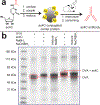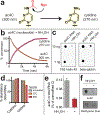Profiling Cytidine Acetylation with Specific Affinity and Reactivity
- PMID: 29039931
- PMCID: PMC7900898
- DOI: 10.1021/acschembio.7b00734
Profiling Cytidine Acetylation with Specific Affinity and Reactivity
Abstract
The human acetyltransferase NAT10 has recently been shown to catalyze formation of N4-acetylcytidine (ac4C), a minor nucleobase known to alter RNA structure and function. In order to better understand the role of RNA acetyltransferases in biology and disease, here we report the development and application of chemical methods to study ac4C. First, we demonstrate that ac4C can be conjugated to carrier proteins using optimized protocols. Next, we describe methods to access ac4C-containing RNAs, enabling the screening of anti-ac4C antibodies. Finally, we validate the specificity of an optimized ac4C affinity reagent in the context of cellular RNA by demonstrating its ability to accurately report on chemical deacetylation of ac4C. Overall, these studies provide a powerful new tool for studying ac4C in biological contexts, as well as new insights into the stability and half-life of this highly conserved RNA modification. More broadly, they demonstrate how chemical reactivity may be exploited to aid the development and validation of nucleobase-targeting affinity reagents designed to target the emerging epitranscriptome.
Conflict of interest statement
The authors declare no competing financial interest.
Figures




References
-
- Tan TZ, Miow QH, Huang RY, Wong MK, Ye J, Lau JA, Wu MC, Bin Abdul Hadi LH, Soong R, Choolani M, Davidson B, Nesland JM, Wang LZ, Matsumura N, Mandai M, Konishi I, Goh BC, Chang JT, Thiery JP, and Mori S (2013) Functional genomics identifies five distinct molecular subtypes with clinical relevance and pathways for growth control in epithelial ovarian cancer. EMBO Mol. Med 5, 1051–1066. - PMC - PubMed
-
- Zhang H, Hou W, Wang HL, Liu HJ, Jia XY, Zheng XZ, Zou YX, Li X, Hou L, McNutt MA, and Zhang B (2014) GSK-3beta-regulated N-acetyltransferase 10 is involved in colorectal cancer invasion. Clin. Cancer Res 20, 4717–4729. - PubMed
-
- Lv J, Liu H, Wang Q, Tang Z, Hou L, and Zhang B (2003) Molecular cloning of a novel human gene encoding histone acetyltransferase-like protein involved in transcriptional activation of hTERT. Biochem. Biophys. Res. Commun 311, 506–513. - PubMed
-
- Shen Q, Zheng X, McNutt MA, Guang L, Sun Y, Wang J, Gong Y, Hou L, and Zhang B (2009) NAT10, a nucleolar protein, localizes to the midbody and regulates cytokinesis and acetylation of microtubules. Exp. Cell Res 315, 1653–1667. - PubMed
MeSH terms
Substances
Grants and funding
LinkOut - more resources
Full Text Sources
Other Literature Sources

